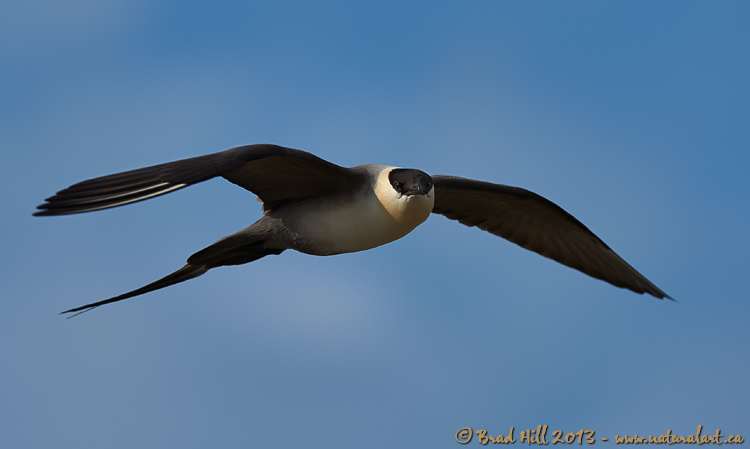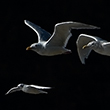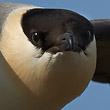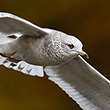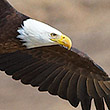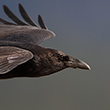Availability: Undetermined - Enquiries?
In the Field
Eyes of the Predator - Long-tailed Jaeger. Victoria Island, Nunavut, Canada. June 30, 2013.
I readily admit I have a fondness for photographing animals that reside on the top end of the food chain - the predators. Think bears, wolves, coyotes, and other sharp-toothed members of Class Mammalia. And, on the avian side I do prefer photographing species of eagles, hawks, and owls over most other birds. Part of the reason is that I find predators more interesting from a behavioural perspective (and I didn't spend years studying animal behaviour on just a whim!) - I find them more animated and behaviourally diverse than most herbivores. And, for some reason, they have amazingly expressive eyes - when a predator stares at you, you FEEL something. Don't ask me what it is...perhaps a feeling that the animal is sizing you up (hmmmm...wonder what HE tastes like?) or maybe it's just the feeling that the animal is looking right into you. Regardless of the reason - when a predator stares at you it feels a whole lot different than when a herbivore does!
This is a shot of a "different sort" of predator - a Long-tailed Jaeger. Jaegers are members of the order Charadriiformes - a diverse group that includes shorebirds, gulls, and auks. Jaegers are the smallest members of the Skua family (more formally known as the Stercorariidae) and are voracious predators. They nest on the tundra of the high arctic and their breeding success is closely tied to the availability of the collared lemming. Interestingly, when a jaeger hunts down a lemming it uses only its bill (and never its feet, which lack talons) and literally pecks its prey to death.
I photographed this jaeger on Victoria Island in Canada's arctic region. Watching a jaeger hunt - with its amazing aerial agility and ability to instantly change direction - is a real treat. This one seemed plain curious about our group - we had no reason to believe we were near its nest, yet it repeatedly flew towards us and gave us a good, hard look. And when it did, I felt exactly the same as when any other predator stares at me - and there seemed to be a level of intelligence behind those eyes that we simply can't understand. Cool experience.
Here's a higher resolution version of the image - I think it better conveys the intensity of the stare this magnificent bird gave me as it did its fly-by:
• Eyes of the Predator - Long-tailed Jaeger Download 2400 pixel image (JPEG: 535 KB)
NOTE: Like all images on this website, this image is protected by copyright - I'm fine with personal uses of it, but unauthorized commercial use of the image is prohibited by law. Thanks in advance for respecting my copyright!
Behind the Camera
Eyes of the Predator - Long-tailed Jaeger. Victoria Island, Nunavut, Canada. June 30, 2013.
Digital Capture; Compressed RAW (NEF) 14-bit format; ISO 100.
Nikon D4 paired with Nikkor 400mm f2.8 VRII lens. Hand-held. VR on and in normal mode. 51-point Dynamic Area AF mode with centre-most AF bracket selected (for initial focus acquisition).
1/2000s @ f5; -0.33 stop compensation from matrix-metered exposure setting.
At the Computer
Eyes of the Predator - Long-tailed Jaeger. Victoria Island, Nunavut, Canada. June 30, 2013.
RAW Conversion to 16-bit TIFF, including first-pass/capture sharpening using Capture One Pro version 7. Three raw variants (images processed from raw) differing by a total of 0.67 stops in total exposure.
Further digital corrections on resulting 16-bit TIFF files using Adobe's Photoshop CC and Light Craft's LightZone. Photoshop adjustments included compositing/blending of the three exposure variants, very minor colour tweaks (hue rotation and desaturation of selected colours), further selective exposure tweaks and selective contrast adjustment, and selective sharpening for web output. Final tone tweaking performed using tonemapper/re-light tool in Lightzone.
Conservation
Eyes of the Predator - Long-tailed Jaeger. Victoria Island, Nunavut, Canada. June 30, 2013.
Species Status in Canada*: Not considered at risk in the immediate future, but population status and population trends poorly understood (see below).
The Long-tailed Jaeger (Stercorarius longicaudus) is the smallest of the three jaeger species - and the most graceful in flight. These predaceous birds breed in the high arctic and when outside of the breeding season they are normally found over open ocean (they are only rarely observed near shore).
When breeding the Long-tailed Jaeger's diet consists primarily of lemmings and voles - which means this jaeger is vulnerable to the wild fluctuations in population sizes of these rodents. In a year with low lemming numbers Long-tailed Jaegers will often simply not breed. But, because the breeding season is the only time when they are dependent on terrestrial rodents as a food source, they can easily survive crashes in rodent numbers without the high mortality experienced by other arctic predators.
There are no detailed estimates of the total numbers of Long-tailed Jaegers or of population trends. There have been no attempts to manage natural populations but it is known that maintenance of these birds in captivity is difficult. There is only minimal hunting of these birds by humans and while they are probably subject to contamination by pollutants in oceans, at this time human activity does not appear to be endangering the Long-tailed Jaeger.
*as determined by COSEWIC: The Committee on the Status of Endangered Wildlife in Canada













